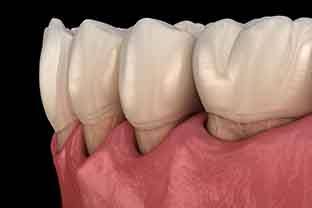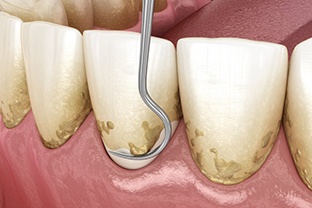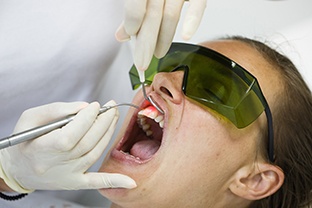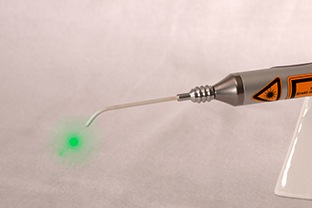Gum Disease Treatment – Peabody, MA
Protect Your Smile with Gum Disease Treatment

Gum disease is a dangerous bacterial infection of the gum tissue that if left untreated can cause a variety of problems throughout the mouth and body. Gum disease treatment can help reduce the number of bacteria in your mouth and prevent it from further harming your oral and overall health. While each patient’s treatment plan will look different, here are some of the methods Dr. Saati may use to treat your gum disease and protect your teeth and gums.
Why Choose Dr. Spiro Saati for Gum Disease Treatment?
What is Gum Disease?

Gum disease, also known as periodontal disease, is caused by a bacterial infection within the mouth that directly affects the gums and bone structure that supports the teeth.
There are two types of gum disease: gingivitis, which is the earliest stage of gum disease, and periodontitis, which is the more advanced stage.
Thankfully, gingivitis can often be reversed by improving your oral hygiene routine. However, periodontitis cannot be cured, only managed, to prevent worsening effects such as tooth and bone loss.
Factors that could increase your risk of developing gum disease include:
Symptoms of Gum Disease

Gum disease can cause a variety of symptoms, depending on how far the condition has progressed.
Signs of gingivitis:
Signs of periodontitis:
How Do We Treat Gum Disease?

Before determining which gum disease treatment options are best for you, Dr. Saati will thoroughly examine your mouth to determine the severity of your condition. Based on his findings, he will discuss all your treatment options with you and develop an appropriate treatment plan.
Scaling & Root Planing

Dental decay isn’t the only thing that can threaten your pearly whites; infection in the gum tissue can be harmful to the rest of your mouth. In many cases, periodontal disease can be addressed in its early stages by getting rid of the plaque and tartar in the affected area. This deep cleaning is known as scaling and root planing—a straightforward process designed to protect your smile from potential bacteria and infection. If Dr. Saati recommends that you undergo this treatment, here’s what you can expect from it before coming in for your appointment.
Do You Need Scaling & Root Planing?

Generally speaking, our team will recommend this service if a patient is showing signs of gum disease that has advanced further than normal. Some of the common reasons we’ll suggest scaling and root planing are if you have some of the following symptoms:
- Receding gum line
- Bleeding in the gums during flossing and brushing
- Trouble biting down or chewing
- Visible plaque and tartar buildup
- Chronic bad breath
Should you notice any of the above indications, make sure to notify our team so that Dr. Saati can evaluate your gums to check if scaling and root planing will be required. This treatment will likely be recommended if you have a more advanced gum infection.
The Process of Scaling & Root Planing

Scaling and root planing is a two-part process that can typically be completed in two appointments.
First, we will thoroughly remove all the plaque and tartar from the teeth to minimize bacteria presence. If you have experienced any gum recession, we will scale the area as far down as the pockets of your gums to make sure there are no bacteria left hiding in the area.
When you return for your second appointment, we will smooth the surface of the roots of your teeth, removing any hardened bacterial deposits. This will help your gum tissue reattach to your tooth’s structure, protecting the roots.
Aftercare Tips for Scaling & Root Planing

It’s normal to experience some tenderness and mild discomfort for several days following scaling and root planing. Your teeth might also be slightly sensitive, and your gums may experience minor inflammation. This is normal and can be easily managed by taking over-the-counter pain medications. During your recovery, you’ll need to protect your smile by brushing and flossing regularly to prevent infection. Be sure to avoid eating spicy, sharp, or excessively hot foods while you are recovering.
Our team can provide specific guidelines on taking care of your smile, and we may even prescribe you an antibiotic or special mouthrinse to help your gums heal. If you notice any discomfort that lasts longer than a couple of weeks or gets worse, notify us right away for help.
Antibiotic Treatment

In addition to root scaling and planing, Dr. Saati may prescribe an oral antibiotic treatment. This will be in pill form and will target the origin of your infection while it prevents your symptoms from worsening. Be sure to follow the medication’s instructions exactly as prescribed, as failure to do so may affect its effectiveness.
Laser Periodontal Treatment

If left untreated, gum disease can cause more than just gums that bleed when you brush and floss. This bacterial infection can lead to receding gums, tooth sensitivity, tooth loss, and even jawbone deterioration. With laser periodontal treatment, your dentist uses a powerful laser to reduce the number of bacteria that have colonized in your gums, all the while removing severely infected gum tissue. Laser therapy has become the gold standard in periodontal treatment, eliminating the need for a scalpel and stitches, reducing bleeding and discomfort, and lowering your risk of reinfection.
How Laser Periodontal Treatment Works

Laser periodontal treatment is not a standalone procedure. It is frequently done in conjunction with scaling and root planing, a deep cleaning treatment that removes built-up bacterial deposits. It can also be used to treat various stages of gum disease, reducing inflammation and preventing infection from spreading.
Instead of having to remove severely damaged gum tissue with a scalpel, your dentist can now use a dental laser to remove only what is needed, minimizing bacteria as it works. This is drastically less invasive and much more comfortable for the patient. Furthermore, because the laser helps kill the bacteria as it goes, your body is better able to fight off the infection and heal.
Your dentist will remove any inflamed tissue from around the teeth, leaving behind only healthy tissue. This healthy tissue must then reattach to your tooth to protect its vulnerable root structure. If bacteria gain access to these roots, it can increase your risk of tooth loss.
Once the damaged tissue is removed, your dentist can begin the scaling and root planing process. During this stage, they will remove plaque and tartar from the teeth and plane the roots to allow healthy gum tissue to reattach to the tooth.
The Benefits of Laser Periodontal Treatment

Using a laser instead of the traditional scalpel instantly makes your periodontal treatment much less invasive. In fact, with laser therapy there’s no need for sutures, either. Studies have even shown that lasers result in a more comfortable treatment and lead to less post-operative discomfort, and because it cauterizes your gums as it works, it minimizes after-effects such as bleeding and inflammation and reduces the risk of future infections. Furthermore, because lasers emit a very small point of light, your dentist can precisely target only the tissue that needs to be removed.
Aftercare Tips for Laser Periodontal Treatment

Following your laser periodontal therapy treatment, you can expect a relatively fast recovery. Most patients are completely healed within about a week, as compared to the two to four weeks it could take with non-laser treatments.
You can expect some slight swelling or sensitivity following the procedure. This is completely normal. In many cases, over-the-counter pain relievers such as ibuprofen can successfully manage any discomfort.
Be sure to stay on top of your oral hygiene habits going forward. This includes brushing twice a day and flossing once a day.
If you’re experiencing any sensitivity, avoid any food or beverage that is too hot, cold, or spicy.
After your procedure, you will likely need a follow-up with your dentist to monitor your progress. However, should you experience anything out of the ordinary or if your pain worsens instead of improving, reach out to your dentist as soon as possible.